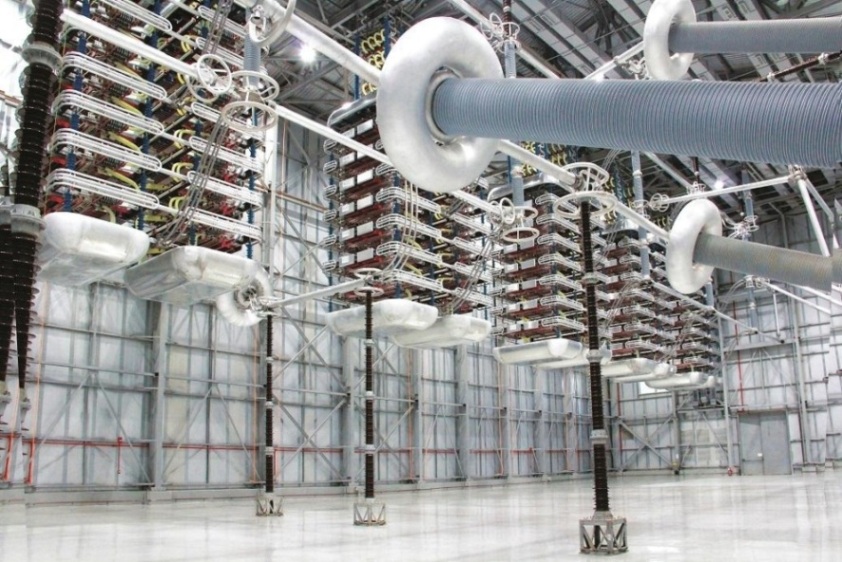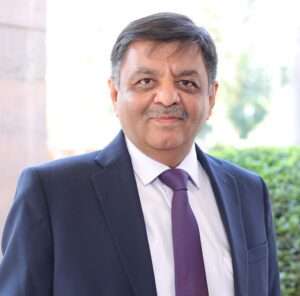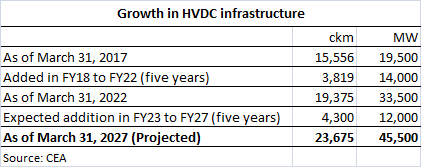HVDC power transmission gaining prominence, major capacity build-up in the pipeline
- April 30, 2024

The quantum of interregional electricity transfer through HVDC lines appears to have increased significantly in FY24, as borne out by newly-released statistics by GRID-INDIA.
In FY24, the total interregional electricity transfer stood at 249,487 MU (million units) as against 236,153 MU in FY23 – a growth of 5.6 per cent. Of this, transfer through HVDC lines in FY24 was 80,405 MU, up 23.8 per cent over the comparable 64,951 MU in FY23.

The share of interregional transfer through HVDC lines rose to 32.2 per cent in FY24 from 27.5 per cent in FY23.
It is expected that as India’s renewable energy capacity increases, in its quest to attain 500 GW of non-fossil capacity by 2030, HVDC lines will play an even more prominent role in interregional power transmission.

From a technical perspective, HVDC technology is best suited for long-distance power transmission as well for transmission of electricity generated from renewable energy sources.
Discussing the intrinsic advantages of HVDC technology, Sandeep Zanzaria, CEO & MD, GE T&D India, observed, “HVDC technology plays a crucial role in India’s dynamic power transmission sector. It offers multiple advantages that include enhancing transmission capacity, minimizing losses, and providing the flexibility needed for integrating renewables. It is a critical technology that ensures a reliable, efficient, and future-ready power transmission infrastructure for a fast growing economy like India. HVDC strengthens grid stability by facilitating power exchange between regions and enabling integration of renewables with variable generation.”
Major HVDC lines
Out of the nine HVDC lines that India currently has, the Champa-Kurukshetra, Talcher-Kolar and Raigarh-Pugalur are the most important ones with respect to quantum of interregional power transfer. All these three lines are owned by Power Grid Corporation of India Ltd (PGCIL).
In FY24, the Raigarh-Pugalur line (details presented ahead) was the busiest line transferring 23,713 MU from the western region grid (WR) to the southern grid (SR). The Talcher-Kolar HVDC line ferried 13,355 MU from the northern region grid (NR) to SR, while the Champa-Kurukshetra HVDC line transferred 16,508 MU from WR to NR.
Growth of HVDC infrastructure in India
The commissioning of PGCIL’s ±800kV Raigarh-Pugular line with an onward ±320kV extension to Thissur in Kerala has been an important achievement in India’s attempt to shore up HVDC-based power transmission infrastructure, in recent history. This line was commissioned in phases with full commissioning taking place in Q3 (October to December) of FY22.
The ±800kV Raigarh-Pugalur line traverses 1,750 km from Chhattisgarh to Tamil Nadu traversing Maharashtra, Andhra Pradesh and Telangana en route. It has a transfer capacity of 6,000 mw. The ±320kV Pugalur-Trichur link, traveling 153 km, is an extension of the Raigarh-Pugalur bipolar link and has a transfer capacity of 2,000 mw. Interestingly, Pugalur-Trichur line deployed innovative VSC (voltage source converter) technology and even had around 27 km of EHV underground cabling.
During the five-year period from FY18 to FY22 (April 1, 2017 to March 31, 2022), India added a total of 3,819 ckm of HVDC lines against the targeted 4,040 ckm. In terms of HVDC-based transformation (transfer) capacity, the achievement was 14,000 mw, fully meeting the target set for the period. Much of this addition came from the Raigarh-Pugalur-Trichur HVDC system.
As of March 31, 2022, India’s HVDC-based network stood at 19,375 ckm with accompanying transfer capacity of 33,500 mw. This includes lines across all voltages, namely ±320kV, ±500kV and ±800kV. India did not experience any addition of HVDC lines or substations during the past two years – FY23 and FY24. Hence, this HVDC base remained unchanged as of March 31, 2024.
 Nevertheless, the coming years are likely to witness significant addition of HVDC-based power transmission infrastructure. In the recently-released “Draft Electricity Plan (Vol.2),” Central Electricity Authority (CEA) has estimated that during the five-period from FY23 to FY27 (April 1, 2022 to March 31, 2027), India is likely to see the addition of 4,300 ckm of HVDC lines and 12,000 mw of transfer capacity. This would take India’s HVDC network to 23,675 ckm with transfer capacity of 45,500 mw, by March 31, 2027.
Nevertheless, the coming years are likely to witness significant addition of HVDC-based power transmission infrastructure. In the recently-released “Draft Electricity Plan (Vol.2),” Central Electricity Authority (CEA) has estimated that during the five-period from FY23 to FY27 (April 1, 2022 to March 31, 2027), India is likely to see the addition of 4,300 ckm of HVDC lines and 12,000 mw of transfer capacity. This would take India’s HVDC network to 23,675 ckm with transfer capacity of 45,500 mw, by March 31, 2027.
What is inspiring to note is that upcoming HVDC-based transmission infrastructure can potentially have significant private participation as developers. It is estimated that currently around 40 interstate transmission system (ISTS) schemes are under bidding, some of these envisaging HVDC infrastructure. An estimated 5,500 ckm of HVDC lines and some 14,500 mw of transfer capacity are expected to come up through ISTS-TBCB schemes, though not all the 40-odd schemes under bidding envisage HVDC infrastructure.
Apart from ISTS-TBCB schemes, PGCIL will also be developing HVDC-based interstate and interregional transmission infrastructure under the regulated tariff mechanism (RTM) route. An important case in point is PGCIL’s mega Ladakh HVDC project that will help evacuate 13 GW of renewable energy from Ladakh region. Using a combination and AC and DC technologies, this project, estimated to cost upwards of Rs.20,000 crore, will entail 480 km of ±350kV HVDC lines (in a total of 713 km) and two HVDC terminals of 5 GW each, at Pang (Ladakh) and Kaithal (Haryana). It is estimated that PGCIL will be placing equipment orders for this mega HVDC project by around March 2025.
Epilogue
While India clearly needs HVDC-based power transmission infrastructure, in view of the huge renewable energy capacity envisaged, there are some concerns that need to be addressed. One impediment is that even worldwide there are limited suppliers of HVDC-related equipment. Further, the demand for HVDC transmission is increasing globally, especially in developed countries that are pushing aggressively towards clean energy, much like India.
Nevertheless, key suppliers like GE T&D India are fully geared up to meet the upcoming demand for HVDC equipment. “GE T&D India, part of GE Vernova Grid Solutions business, has a significant play across the power supply chain, offering a wide range of products and services, including HVDC power transmission solutions tailored to India’s unique needs. With five manufacturing sites in the country, GE T&D India is future-ready to meet the industry’s growing demand for grid equipment and services,” noted Sandeep Zanzaria, CEO & MD, GE T&D India.
Despite the challenges, it is very clear that HVDC technology will play an important role in shaping India’s future transmission grid. Corroborating this and expressing confidence that GE T&D India can contribute to India’s upcoming power transmission backbone, Sandeep Zanzaria, said, “GE T&D India has a long history of delivering and commissioning noteworthy projects in the country, showcasing our commitment to the modernization of India’s grid infrastructure through the supply of locally manufactured equipment in alignment with the government’s Make in India initiative. We are seeing technology domains like HVDC both LCC and VSC, STATCOM, digital substations forming the backbone for future growth. And we are dedicated to co-creating a sustainable and resilient energy future for India.”
Also read: HVDC Transmission Planned For Khavda RE Scheme
(Key to abbreviations: HVDC=high voltage direct current; VSC = voltage source converter; LCC = line-commutated converter; STATCOM = static synchronous compensator)
(Featured photograph courtesy of GE T&D India)


